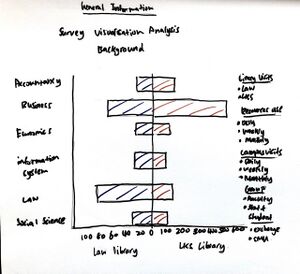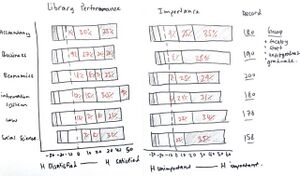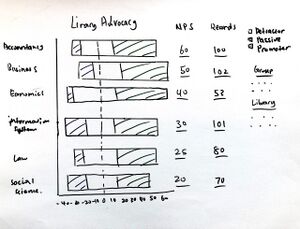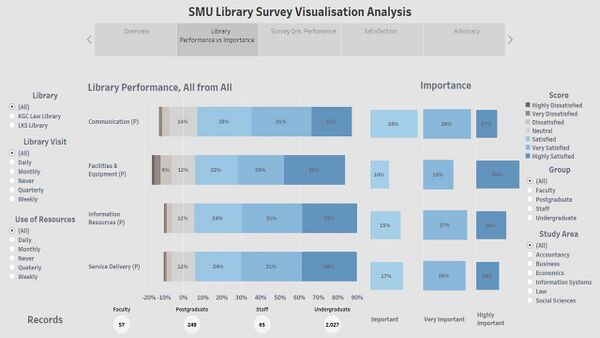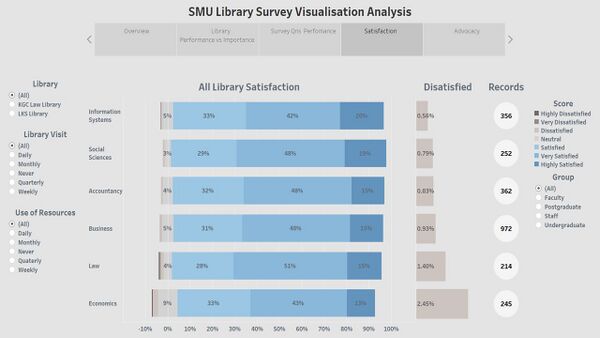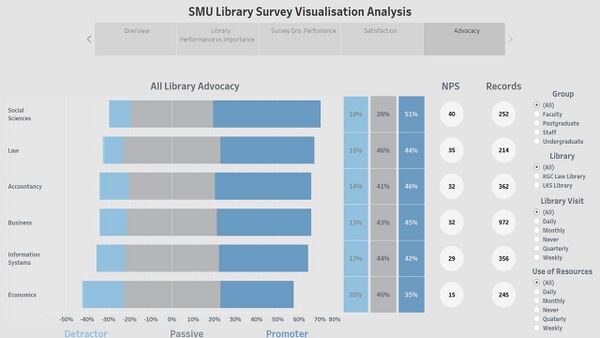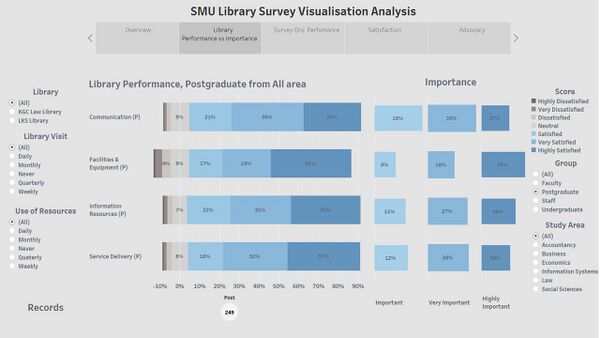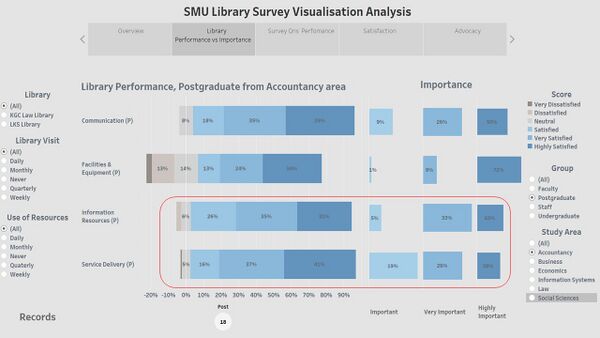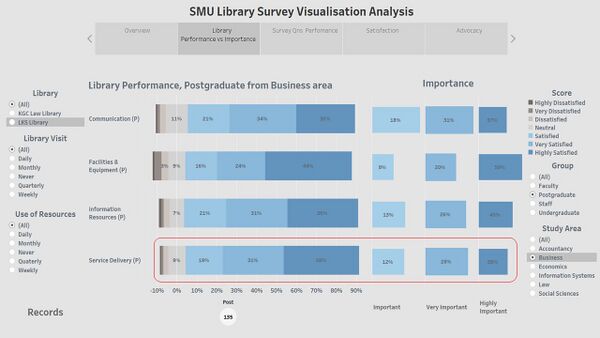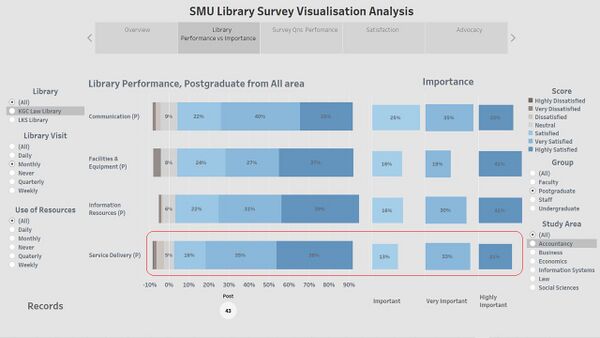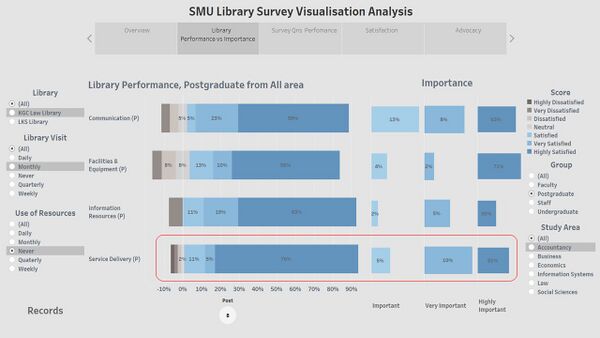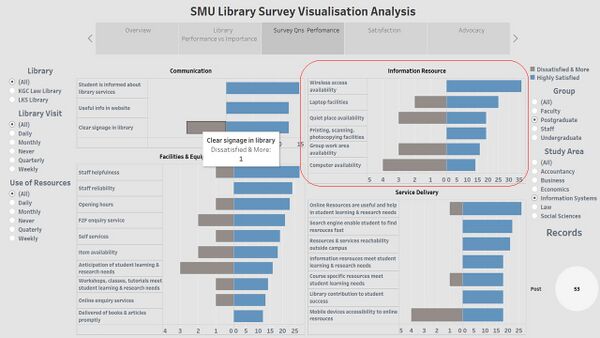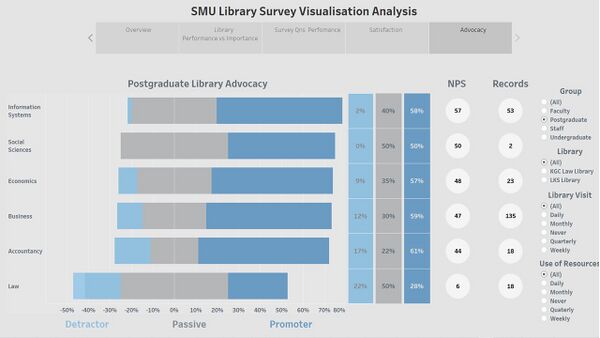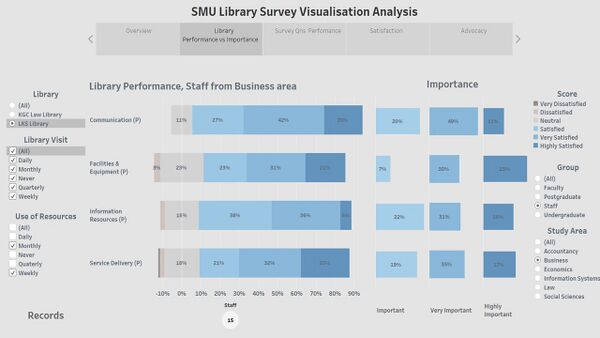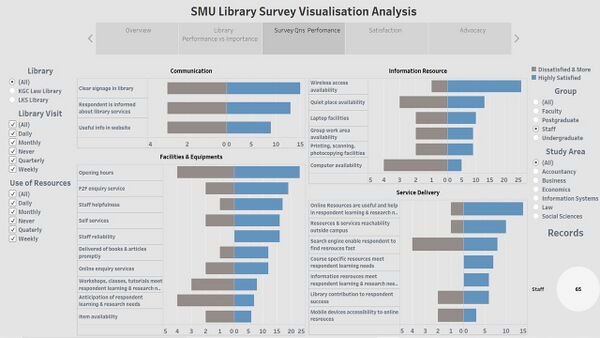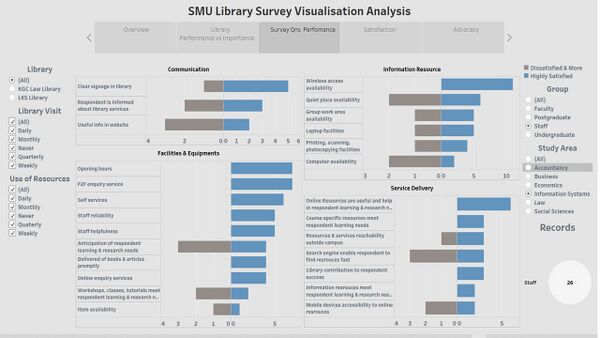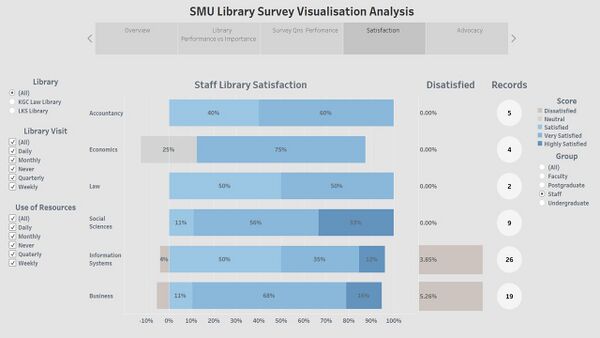Difference between revisions of "IS428 AY2019-20T2 Assign NG JUN HONG"
(→Staff) |
(→Staff) |
||
| Line 276: | Line 276: | ||
|| | || | ||
[[File:Slide21.jpg|600px|frameless|center]] | [[File:Slide21.jpg|600px|frameless|center]] | ||
| − | || | + | ||<center>'''Library Performance vs importance (Staff)'''<center> |
| + | *65 respondents from staff. SMU library perform fairly well for all areas with 7%-14% neutral, 25-35% satisfied, 29% - 36% very satisfied, and 19% - 24% highly satisfied. Dissatisfaction contribute to about 5-8% of each areas in the divergent chart. The gap between highly satisfied and highly important have highest of 6% in information resource area. Whereas, it was the same for communication area, and highly satisfied in facilities & equipment and service delivery areas had exceeded highly important by 2-5%. Therefore, SMU library should maintain its service level in the areas and seek improvement in information resource area for the staff. | ||
| + | |||
|- | |- | ||
| <center>'''2'''</center> | | <center>'''2'''</center> | ||
|| | || | ||
[[File:Slide32.jpg|600px|frameless|center]] | [[File:Slide32.jpg|600px|frameless|center]] | ||
| − | || | + | || |
| + | *15 staffs from business study area that uses library resources in a monthly or weekly basis contributed to the most in disparity between highly satisfied and highly important. Monthly and weekly basis can consider quite frequent. Therefore library could improve their resources in information resource that are used by business staffs frequently. | ||
|- | |- | ||
| + | |||
| <center>'''3'''</center> | | <center>'''3'''</center> | ||
|| | || | ||
[[File:Slide23.jpg|600px|frameless|center]] | [[File:Slide23.jpg|600px|frameless|center]] | ||
| − | || | + | || <center>'''Survey Qns Performance (Staff)'''<center> |
| + | *Information resource –’computer availability’, service delivery – ‘library search engine enable respondent to find resources quick’ , facilities & equipment – ‘opening hours and anticipation of respondent learning & research needs’ have the highest dissatisfaction in their segments respectively. For communication segments, the dissatisfaction were equally distributed of 3 respondents in dissatisfaction. Also, more than 30% of the staffs were highly satisfied in ‘opening hours’, F2F enquiry service’ in facilities & equipment segment and ‘wireless access availability in information resource segment. The rest of the questions have a consistent of 7 – 15 highly satisfied voted. | ||
|- | |- | ||
| Line 293: | Line 298: | ||
|| | || | ||
[[File:Slide34.jpg|600px|frameless|center]] | [[File:Slide34.jpg|600px|frameless|center]] | ||
| − | || | + | || |
| + | *Out of 5 Staffs in accountancy study area, only 1 respondents indicated dissatisfaction from ‘online enquiry services’ in facilities & equipment segment. | ||
|- | |- | ||
| Line 300: | Line 306: | ||
|| | || | ||
[[File:Slide25.jpg|600px|frameless|center]] | [[File:Slide25.jpg|600px|frameless|center]] | ||
| − | || | + | || |
| + | *Staffs with the most records of 26 in information systems has generally low dissatisfaction, especially in facilities & equipment. | ||
| + | |||
|- | |- | ||
| Line 307: | Line 315: | ||
|| | || | ||
[[File:Slide26.jpg|600px|frameless|center]] | [[File:Slide26.jpg|600px|frameless|center]] | ||
| − | || | + | || |
| + | *Staffs in social sciences shows that there were no dissatisfaction from facilities & equipment and information resources segments. | ||
|- | |- | ||
| Line 314: | Line 323: | ||
|| | || | ||
[[File:Slide27.jpg|600px|frameless|center]] | [[File:Slide27.jpg|600px|frameless|center]] | ||
| − | || | + | || |
| + | *Meanwhile, we can see that staffs in business which has the second highest record in staff survey, contributed the most dissatisfaction indicated in facilities & equipment and information resource. Therefore, SMU library can look into how to enhance service level for staffs in business. | ||
|- | |- | ||
| Line 321: | Line 331: | ||
|| | || | ||
[[File:Slide28.jpg|600px|frameless|center]] | [[File:Slide28.jpg|600px|frameless|center]] | ||
| − | || | + | || |
| + | *Staffs in accountancy and law study areas only had satisfaction ratings but no highly satisfied were indicated. Moreover, there were no dissatisfied and neutral ratings. | ||
| + | Similarly, staffs in economics study area have only very satisfied rating with one of the staff giving neutral rating. | ||
| + | Staffs in information systems and business study areas contain the highest number of respondents with information systems area having majority satisfied rating of 50% and business area having majority very satisfied rating of 68%. Lastly, staffs in social sciences is the one with the highest highly satisfied rating. Hence, SMU library had done exceptionally well in term of service level for staffs in social sciences. | ||
| + | In conclusion, SMU library had done well in terms of staffs satisfaction but could still do better as the percentage of highly satisfied were very low. | ||
|- | |- | ||
| Line 328: | Line 342: | ||
|| | || | ||
[[File:Slide29.jpg|600px|frameless|center]] | [[File:Slide29.jpg|600px|frameless|center]] | ||
| − | || | + | || |
| + | *Staffs in social sciences study area is the top advocate for SMU library with NPS of 67. Whereas staffs in business, accountancy and information systems study areas can do better. A little concern will be staffs in economics and law study areas as they have NPS of 0. However the records for staffs were very low with 4 from economics and 2 from law compare to business and information systems with 19 and 26 records. Hence, this may not be a constructive feedback of advocacy, as 4 and 2 record is hard to represent the corhort of staffs in economics and law. | ||
|- | |- | ||
Revision as of 21:01, 14 March 2020
Contents
Background
Every two years, SMU Libraries conduct a comprehensive survey in which faculty, students and staff have the opportunity to rate various aspects of SMU library's services. The survey provides SMU libraries with input to help enhance existing services and to anticipate emerging needs of SMU faculty, students and staff.
Objectives
With massive respondents' feedback obtain from the surveys. I am task to use visual analytics approach to reveal the levels of services provided by SMU libraries as perceived by the undergraduate students, postgraduate students, the faculty and the staff.
Summarising Data Set & Planning for Visualisation
| Dashboard | Purpose | Variables Require | Measurement |
|---|---|---|---|
This will be the home dashboard of the visualisation, to summarise the general data of the survey. This include:
|
|||
Visualisation Building Process
|
Data Preparation in Tableau Prep Builder | |
|
Data Preparation in Tableau Prep Builder
|
The interactive visualization can be accessed here:https://public.tableau.com/profile/lim.kim.yong#!/vizhome/VA_Assignment3_Final6/Home_Page
Overview Dashboard
Overview dashboard.This dashboard depicts a pyramid chart with Kwa Geok Choo Law and Li Ka Shing Libraries. It indicates the no. of respondents with interactivities from group, library visit, use of resources, campus visit and student. Overview page allow user to examine the no. of respondents from KGC Law and LKS libraries with the mentioned interactivities.
Library Performance vs Importance
Library Performance vs Importance dashboard. This dashboard shows a divergent chart (Library Performance) as the main visualisation on how well the library performed in 4 of the areas – Communication, Facilities & Equipment, Information Resources and Service Delivery. The score metrics were replaced into 1 - Highly Dissatisfied, 2 – Very Dissatisfied, 3- Dissatisfied, 4 – Neutral, 5 – Satisfied, 6 – Very Satisfied, 7 – Highly Satisfied. Then an indication (Importance) shows percentage of respondents’ thoughts about the importance of the areas, by 5 – important, 6 – very important, 7 –highly important, matching the colour schemes of percentage responds in satisfied, very satisfied and highly satisfied. Lastly, another indication (records) defined the no. of respondents who answered the questions on each of the area. In conclusions, group, study area, library, library visit, use of resources filtering will be use in all dashboards as main indicators to identify patterns and anomalies. The creativity of this dashboard allows user to compare library performance in the 4 areas against respondents’ thoughts of how important each of the area is.
Survey Qns Performance
Survey Qns Performance dashboard. This dashboard shows 4 pyramid charts of each library performance areas – communication, facilities & equipment, information resources and service delivery. Moreover, it consists of all questions asked and responds. The responds are categorised into highly satisfied against dissatisfied & more (dissatisfied, very dissatisfied and highly dissatisfied). This dashboard aid user to identify specific areas to improve and maintain based on the 4 broader areas. Only highly satisfied score was measure and compare as that is what every business, in this case the library’s goal. Vice versa, to convert dissatisfaction segment to satisfaction.
Satisfaction
Satisfaction dashboard. This dashboard shows a divergent chart of respondents’ overall satisfaction by study areas with their respective records.
Advocacy
Advocacy dashboard.This dashboard presents a divergent chart of respondents’ library advocacy by study areas with their respective net promoter scores and records.
Undergraduate
| S/N | screen shot | Insight and Significance |
|---|---|---|
| picture | description | |
| picture | description | |
| picture | description |
Postgraduate
| S/N | screen shotw | Insights |
|---|---|---|
| ||
| ||
| ||
| ||
| ||
Staff helpfulness and reliability in facilities & equipment segment and wireless access availability and laptop facilities in information resource segment had more than 100 respondents rated for highly satisfied. In general, the rest of the components were at a consistent level of between 50 – 100 highly satisfied and 5 – 16 dissatisfied votes from postgraduate. | ||
| ||
| ||
| ||
|
Faculty
| S/N | screen shot | Insight and Significance |
|---|---|---|
| picture | description | |
| picture | description | |
| picture | description |
Staff
| S/N | screen shot | Insight and Significance |
|---|---|---|
| ||
| ||
| ||
| ||
| ||
| ||
| ||
Similarly, staffs in economics study area have only very satisfied rating with one of the staff giving neutral rating. Staffs in information systems and business study areas contain the highest number of respondents with information systems area having majority satisfied rating of 50% and business area having majority very satisfied rating of 68%. Lastly, staffs in social sciences is the one with the highest highly satisfied rating. Hence, SMU library had done exceptionally well in term of service level for staffs in social sciences. In conclusion, SMU library had done well in terms of staffs satisfaction but could still do better as the percentage of highly satisfied were very low. | ||
|
